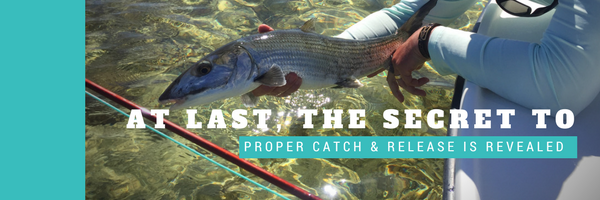
To ensure robust bonefish populations, catch and release fishing is being promoted as a valuable tool for conservation.
This gives bonefishers the chance to flex their skills, capture evidence of their prowess in photos, and return their prey back to the water safely. Unfortunately, however, catch and release techniques are only effective at saving the lives of bonefish when people are diligent about using proper handling techniques. Following are several ways to ensure optimum chances of survival when returning a bonefish back into its natural environment.
Keep Your Hands Clean And Wet
If your hands have been recently slathered in sunblock or any other product, avoid handling bonefish altogether. Your hands should be both clean and wet whenever you’re actively touching a bonefish, whether the fish is in or out of the water. Anything that you do to disrupt their natural slime coating can increase the risk of infection post-release and the likelihood of death.
Use Proper Support
Establishing the right grip on a bone is important as well; especially if you intend to take a photo with your catch before releasing him back in the water. You should comfortably support the fish at the underbelly and the tail. It is also important to avoid keeping the fish out of the water for more than 15 seconds. Keep your hands away from the gills and never use mechanical, lip-gripping tools. These are known to cause significant lip and jaw injuries, as well as a prolonged period of shock. It is far better to use scales to weigh your fish instead.
Choose The Right Hooks For Catch And Release Fishing
The best hooks of these purposes are entirely barb-free. This limits the likelihood of having a hook get stuck and reduces the amount of time that it takes to get the hook back out. If you’ll be fishing for bones with bait, go ahead and use a circular hook instead. When a hook proves impossible to remove, or when it gets lodged deep within the gullet, simply cut the line and leave the hook right where it is. A bonefish will often be able to expel this foreign item all on its own. If not, the hook will likely dissolve over time. Research performed in the Bahamas has shown that the act of leaving a hook has little to no effect on a bonefish’s overall well-being and chances of survival.
Taking Photos With Bonefish
Photos give people the chance to capture lasting evidence of their hauls without having to actually bring their fish back in. To ensure the continued health of the bonefish, avoid taking “hero” shots, and plan your the photos carefully before actually lifting the fish out of the water. Get your camera ready and think about your pose first. To minimize the risks of catch and release photography, it is generally best to capture these images underwater whenever possible.
Helping Bonefish Avoid Predators Post-Release
Not surprisingly, bonefish will be in a temporary state of shock following their out-of-water experiences. Understanding this, you want to avoid releasing a fish in water that’s teeming with predators. If you spot any barracuda or sharks in the immediate vicinity, try setting up a circulating live-well to hold the fish until you can release it in a safe location.








